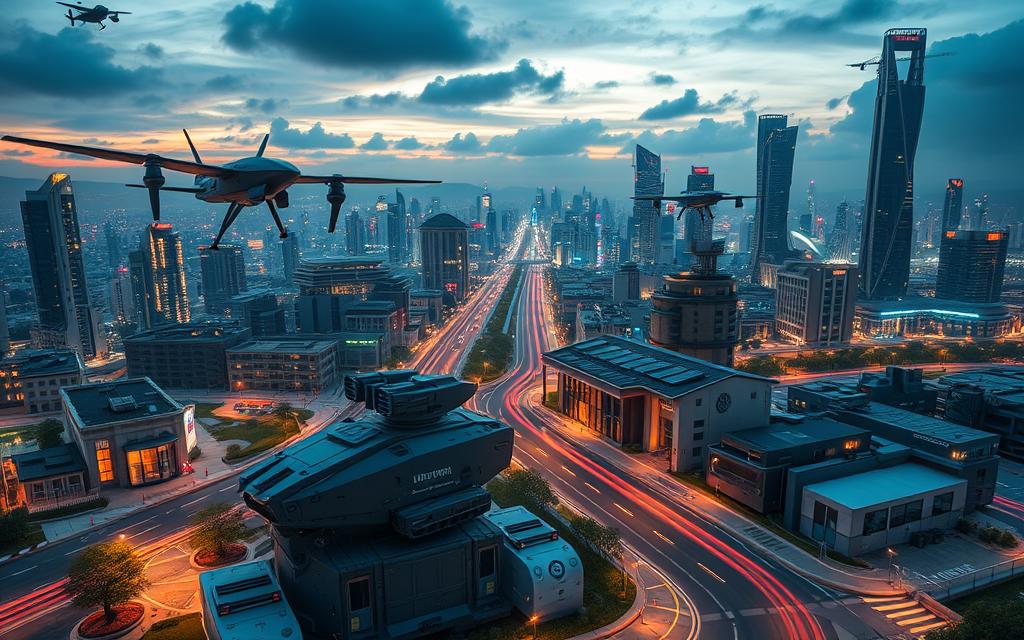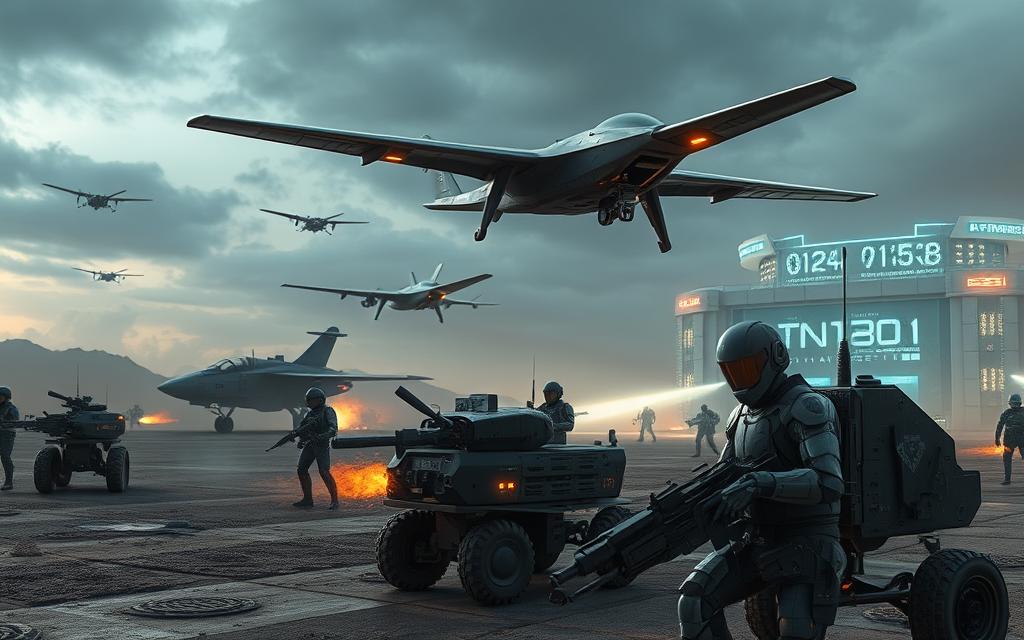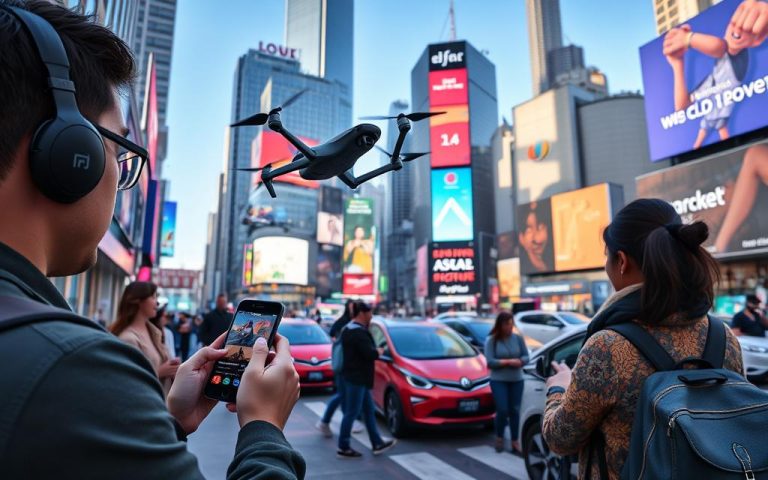How Advanced Is Military Technology Compared to Civilian Tech?
The debate on military versus civilian technology is growing. The main question is how military advancements compare to civilian innovations. Historically, the military has led in tech breakthroughs. But now, civilian technology, especially in AI, is making huge strides.
Companies like Google, OpenAI, and Facebook are at the forefront of AI. This means the military is finding the civilian sector often leads in innovation. We will explore how military and civilian tech developments influence each other. This is key in the discussion on military vs civilian tech.
The Historical Context of Military and Civilian Technological Development
Technology has always been connected with military needs. This link led to big changes in both war and everyday life. The history of military tech shows that war sparked new inventions, mainly in the 20th century. This era saw huge changes in science and engineering, driven by military goals. These changes later helped in civilian life too.
The Rise of Military Technology in the 20th Century
The 20th century was key for military technology, with major progress during both World Wars. World War I introduced poison gas and wireless tech to spot U-boats. This push in science set the stage for more military projects, leading into World War II. In WWII, more money meant new discoveries. Radar and cryptography got better, changing how wars were fought and helping in weather predictions.
After these wars, more money went into science for military use. This led to big inventions like the ENIAC, an early computer, and medical breakthroughs like mass-produced penicillin. These show how military needs led to new tech, paving the way for more discoveries.
Key Innovations Transitioning to Civilian Use
Many military technologies now change how we live. The internet, started for military messages, is now key to our lives. GPS, first for military direction, is in our phones and helps in many ways. Jet engines, from war times, made flying affordable for more people.
To sum up, the story of military and civilian tech shows how war affected innovation in many areas. The tech from the 20th-century wars still influences our lives, proving that military research back then helped in shaping today’s world.
The Current Landscape of Military and Civilian Technology
Today, civilian technology leads the way, marking a major shift. In the past, military tech was ahead. But now, technological advances, especially from big firms and startups, change the game. Areas like artificial intelligence and IT have let civilian tech reach new heights.
The Technological Hegemony of Civilian Sectors
The rise of civilian tech has been driven by big investments and new innovations. Big tech companies create advanced solutions, better than military ones, putting civilian uses in the spotlight. The use of autonomous systems and advanced data analytics marks this new era. Civilian sectors quickly meet market needs, advancing in cybersecurity and intelligent systems. Startups are key, creating a rich ecosystem that also boosts national security.
Shift in R&D Investments between Sectors
Research and development funding now favors civilian sectors more. The Department of Defense works more with startups to enhance national security. This approach makes sure the military gets innovative civilian solutions. The DOD’s AI strategy, supported by startups, advances AI/ML for defense. Billions are spent updating data and AI systems, showing a strong tie between defense and tech.
| Sector | Investment Focus | Key Areas of Growth |
|---|---|---|
| Military | AI/ML, Cybersecurity, Autonomous Systems | Advanced Manufacturing, Verticalised Solutions |
| Civilian | Data Analytics, Cybersecurity, Autonomous Technologies | Public Health, Biotech Applications, Economic Competitiveness |
Dual-use technologies link military and civilian tech. They push technology forward, making sure security keeps pace with fast changes.

How Far Ahead Is the Military Technology?
Military technology is advancing far beyond civilian tech. Its growth is fuelled by secrecy and huge budgets. Agencies like DARPA lead the way in creating new tech. This allows them to work on new technologies without public scrutiny.
Secrecy and Funding in Military Research
Military research funding has changed a lot over the years. In 1960, the Defence Department had 36% of global R&D spending. Now, it’s only 3%. This shows how government investment in research has decreased. But the Defence Department still spends about $800 billion each year. This budget helps them stay ahead, especially in robotics and autonomous systems.
Examples of Supremacy in Defence Technologies
The military’s tech is clearly superior. The U.S. Navy is planning a mix of crewed and uncrewed ships by 2045. The U.S. Army is also upgrading its combat gear. They’re focusing on lighter, safer helmets and body armour.
Here are more ways the military is advancing:
- Additive manufacturing makes supply chains more flexible.
- The U.S. Navy’s large fleet of aircraft carriers shows its naval might.
- The U.S. Army’s Future Combat System will inject $124 billion into modernising its forces.
- American Abrams tanks boast high-tech features like laser range-finders.
These tech advancements give the military a big edge. They highlight the commitment to staying ahead of opponents. This push for better defence tech is ongoing.
The Role of Artificial Intelligence in Both Sectors
Artificial intelligence (AI) is now essential in military and civilian areas. It changes how operations work and improves efficiency. In the military, AI helps do complex tasks with less need for people. This includes using drones, running simulations, and analysing data for intelligence. These efforts are vital for modern warfare and keeping the country safe.
Military Applications of AI
In the military, AI is changing many areas. It’s used in drone swarms, which work together smartly on the battlefield. AI also helps make better strategic decisions by analysing big data fast. The Pentagon is carefully thinking about how to use these technologies responsibly. They want to make sure AI helps but also stays ethical in warfare.
The Influence of Civilian AI Innovations
In civilian life, AI breakthroughs are also affecting the military. New types of AI can process languages and understand images better. This means AI can do more military tasks than before. But, using these new AI systems carefully is important, especially for safety and transparency. As both areas grow, sharing technology and using AI wisely is key for national security.
FAQ
What are the main differences between military technology and civilian technology?
Military tech is for national security, focusing on defence. Civilian tech aims at people’s needs, focusing on innovation. In the past, military tech often led in new advancements. But now, civilian tech, especially in AI and IT, is moving ahead faster.
How has military technology influenced civilian advancements?
Military research gave us the internet, GPS, and jet engines. These were adapted for everyday use, changing our lives greatly.
Why is there a shift in funding from military to civilian technology projects?
More money is going into civilian tech from startups and big companies. This is making military R&D budgets smaller. It shows a big change, with innovation happening more outside of military settings.
What role does secrecy play in military technology advancements?
Keeping secrets is key in military tech to protect against enemies. Agencies like DARPA fund secret research. This helps create new tech that the public often doesn’t know about.
Can you provide examples of current advanced military technologies?
Examples include autonomous drones, high-tech surveillance, and cyber defences. These showcase military strength, standing out even as civilian tech advances.
How is artificial intelligence being used in the military sector?
AI is used in the military for weapons, gathering intelligence, and analysing data. It helps make better decisions and improves operations, affecting national security deeply.
What ethical considerations arise from the use of AI in military applications?
Using AI in the military brings up ethical issues. There are concerns about machines making combat decisions, who is accountable for AI actions, and possible unexpected results. It’s vital to ponder these ethics to responsibly use AI technologies.














